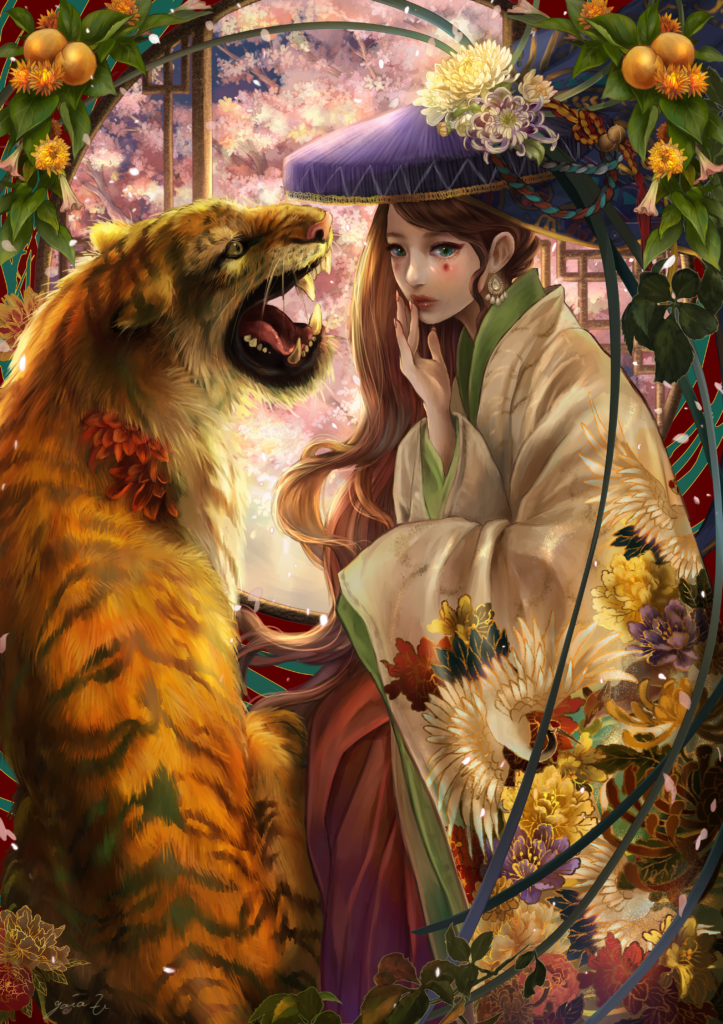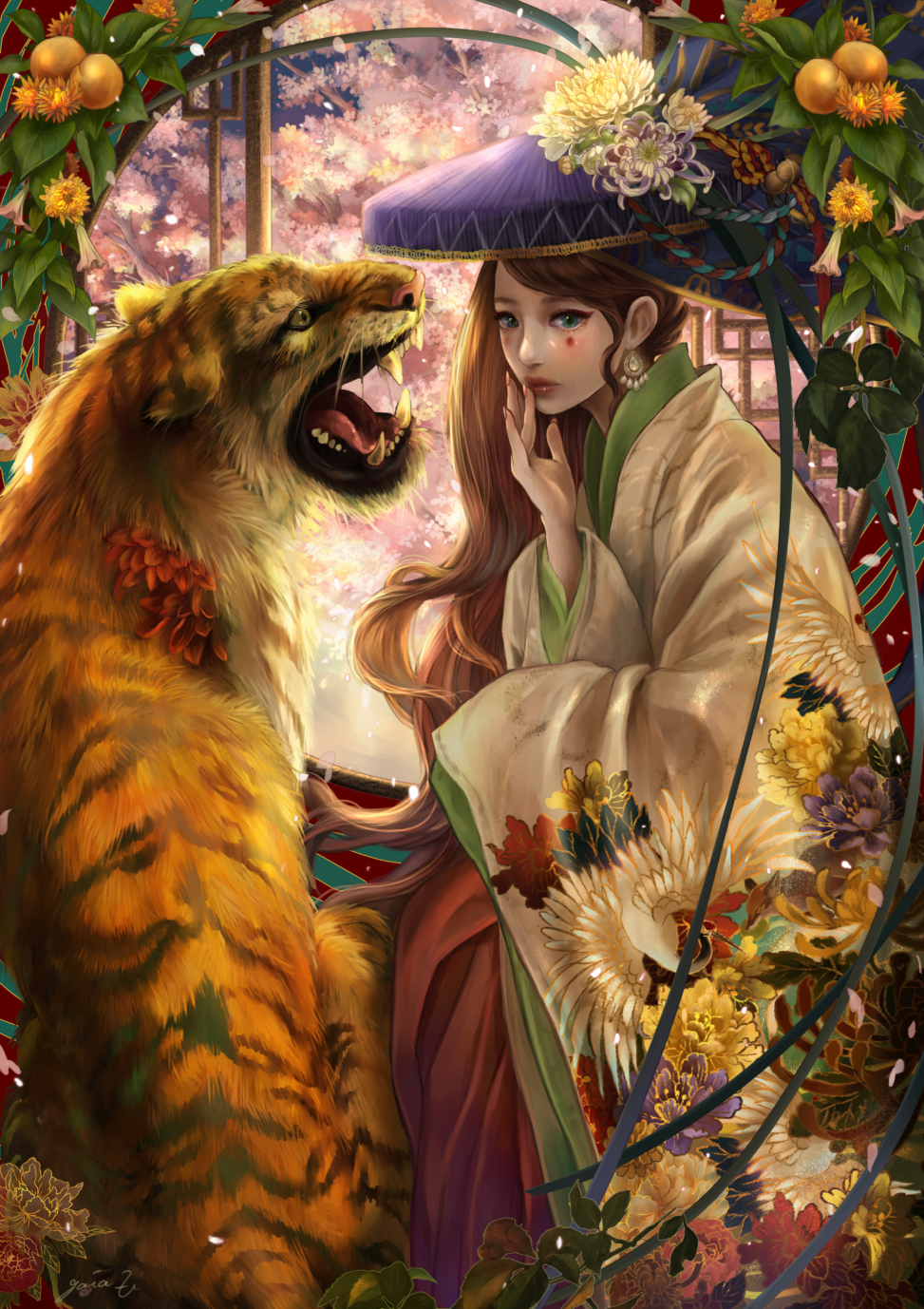
description
彼女は医師だった。
貧しい人たちから治療費を受け取らず、代わりにみんなに杏の種を植えさせた。
杏は漢方の薬になり、そしてみんなの食糧ともなった。
植えた杏の種が杏林にもなった頃、怪我をした虎が彼女を訪ねてやってきた。
彼女は虎の首元の怪我を治療してやると、虎はお辞儀をし去って行ったが、数日後また彼女の前に現れた。
すっかり完治していたので、彼女は帰るように促すが、虎はそこを一歩も動かなかった。
それ以来、虎は彼女が出掛ける時はどこであろうと彼女を背に乗せ送り迎えをし、
夜は家の前で杏の林の番をした。
彼女が亡くなっても、自分の生命が尽きるまで、
何年も何年もそこを動かなかった。
inspired by 神仙伝 虎守杏林
あとがき
今回の作品のテーマは「因果応報」です。
現在ではあまり良い意味として使われませんが、元々は
良い行いをすれば良い報いがあり、悪い行いをすればその報いが返ってくる、行為の善悪によって生じる結果を意味します。
中国の虎守杏林というお話をご存知でしょうか?
神仙伝に出てくる董奉(とうほう)という医者の物語で、
今回の作品では女性をモデルに描いていますが 実際は男性です。
彼は治療費の代わりに患者に杏の苗を植えてもらい、それらはいつしかうっそうと茂るほどの杏の林になったと言います。
そして彼はその実で得た穀物などを 貧しい人たちに分け与えて暮らしました。
この故事から、良医のことを尊敬の念を込めて「杏林」と呼ぶようになったそうです。
あとはdiscriptionに記したとおりです。
そして女性の着物に描かれているデザインですが、これはイソップ寓話の
「狐と鶴」を描いています。
”ある日意地悪な狐が鶴をご馳走に招き、スープを平たい食器で用意し、長いくちばしの鶴はうまく飲むことも出来ず、それを見た狐はおかしそうに笑いました。
今度は鶴が狐を食事に招待すると、細長い瓶に詰めた肉を差し出され、
狐はそれをうまく食べることが出来ずに、鶴に笑われるのでした。”
このお話は、他人を傷つければいつか自分も同じ目に遭うということを教訓としています。
着物のデザインなので華美に描いていますが、鶴に四方から囲まれる狐の図です。怖いですね。
善悪の報いというテーマで、わたしが面白いなと感じた善と悪のふたつの物語を織り込みました。
タイトルは「inside you」
直訳するとあなたの内側という意味です。
あなたのその行いは善なのか悪なのか、
わたしはあなたの心のうちを知りたいのです。
https://foundation.app/@gaia-U/fables/5
description
She was a doctor.
She did not accept money from the poor for medical treatment, but instead had everyone plant apricot seeds.
The apricots became an herbal medicine and food for all.
When the apricot seeds that everyone planted had grown into an apricot grove, an injured tiger came to visit her.
She treated the tiger’s neck injury and he thanked her and left, only to reappear to her a few days later.
The tiger was completely healed and she instructed him to leave, but he never moved a step there.
From then on, the tiger carried her on his back to and from wherever she went, and at night he guarded the apricot grove in front of the house.
When she died, the tiger did not move there for years and years until his own life was over.
inspired by 神仙伝 虎守杏林
after word
The theme of this year’s work is “cause and effect”.
It means that if you do good deeds, you will be rewarded with good rewards, and if you do bad deeds, you will be rewarded with bad rewards, the results of which are caused by the goodness or badness of your actions.
Do you know the story of the 虎守杏林?(hu shou xing lin)
It’s the story of a doctor named Dong Feng in the 神仙伝(Shin sen den).
In exchange for money for his treatment, he asked his patients to plant apricot seedlings, which eventually became a forest of apricot trees.
He then lived off the grain he obtained in exchange for the fruit, which he shared with the poor.
From this legend, the good doctor was called “杏林Kyorin” as a sign of respect.
The rest is as noted in the description.
And the design on the woman’s kimono, which depicts “The Fox and the Crane” from Aesop’s Fable.
“One day, a mean fox invited the cranes to a feast and prepared soup in a flat dish, which the cranes with long beaks could not drink properly.
and the fox laughed at him.
This time, when the crane invited the fox to dinner, he was offered meat in a long, thin jar.
The fox could not eat it well, and the crane laughed at him.”
The lesson of this story is that if you hurt others, someday you will suffer the same.
It is a kimono design, so it is depicted in a flamboyant manner, but it is a picture of a fox surrounded by cranes. It is scary.
I drew two stories of good and evil, which I found interesting, on the theme of good and evil retribution.
The title is Inside You.
Is that deed of yours good or evil?
I want you to tell me what is inside you.

